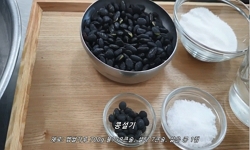벼 주요품종별로 키다리병 감염률을 조사한 결과 자연감염된 12품종 중에서 남평벼 70.8%로 가장 높았으며 호품, 신동진, 호농 순으로 감염률이 높았다. 그러나 발병률은 보석찰이 못자리 및 ...
http://chineseinput.net/에서 pinyin(병음)방식으로 중국어를 변환할 수 있습니다.
변환된 중국어를 복사하여 사용하시면 됩니다.
- 中文 을 입력하시려면 zhongwen을 입력하시고 space를누르시면됩니다.
- 北京 을 입력하시려면 beijing을 입력하시고 space를 누르시면 됩니다.
벼 품종 및 종자 성숙시기별 키다리병 감염과 발생 = Rice bakanae disease of seed infection and disease occurrence according to rice varieties and seed maturation period
한글로보기https://www.riss.kr/link?id=A100326062
- 저자
- 발행기관
- 학술지명
- 권호사항
-
발행연도
2014
-
작성언어
Korean
- 주제어
-
자료형태
학술저널
-
수록면
38-43(6쪽)
- 제공처
-
0
상세조회 -
0
다운로드
부가정보
국문 초록 (Abstract)
벼 주요품종별로 키다리병 감염률을 조사한 결과 자연감염된 12품종 중에서 남평벼 70.8%로 가장 높았으며 호품, 신동진, 호농 순으로 감염률이 높았다. 그러나 발병률은 보석찰이 못자리 및 포장 모두에서 가장 높게 발병됨이 확인되었다. 품종 및 종자성숙 시기별 감염률을 조사한 결과 모든 품종에서 80~100%의 종자 감염률을 나타내었다. 출수기와 유숙기의 발병률의 평균은 49%, 50% 이었으며, 호숙기 36%, 황숙기 29%로 종자 성숙시기가 늦어질수록 발병률은 낮아졌다. 저항성인 남평벼는 출수기 38%, 유숙기 40%, 호숙기 28%, 황숙기 20%의 발병률은 나타내었다. 그러나 감수성으로 알려진 화성벼는 출수기 36%, 유숙기 34%, 호숙기 18%, 황숙기 16%의 발병률을 나타내었다. 키다리병병원균 포자 접종 후 키다리병 발생이 가장 높은 품종은 호품벼이었고 호농이 가장 낮게 발병되었다. 무소독 종자에서는 보석찰에서 키다리병의 발생이 가장 높게 나타났다.
다국어 초록 (Multilingual Abstract)
The natural infected rate and occurrence rate of bakanae disease were investigated among 12 rice varieties depend on growth stages of rice. In case of infection rate, Nampyeong was the highest infected variety among investigated varieties as 70.8 perc...
The natural infected rate and occurrence rate of bakanae disease were investigated among 12 rice varieties depend on growth stages of rice. In case of infection rate, Nampyeong was the highest infected variety among investigated varieties as 70.8 percent. Hopum, Sindongjin, and Honong are also infected highly in natural circumstances. The highest occurrence rates of Boseokchal was investigated the highest in nursery and field both. According to the result which were investigated infection rate on each growth stages of rice, most varieties were infected from 80% to 100%. The average occurrence rates were 49% and 50% at heading stage and milk stage. Even if rice seeds were infected by Bakanae disease pathogen late, bakanae disease occurrence also decreased. Compared with resistant variety, Nampyeong and susceptible, Hwasung, occurrence rate of Nampeong were 38%, 40%, 28% and 20% at heading stage, milk stege, dough ripe stage and yellow ripe stage. However, occurrence rate of Hwasung were 36%, 34%, 18%, 16% at each steges. When pathogen spores were inoculated artificially in field, Hopum was shown the highest occurred as 82%, 78%, 66%, 54% at each stage but Honong was the lowest. In non-disinfection seeds plots, occurrence rate of Boseokchal was the highest.
동일학술지(권/호) 다른 논문
-
- 전북대학교 농업과학기술연구소
- 김보미 ( Bo Mi Kim )
- 2014
-
셀레늄의 엽면시비가 총체보리의 생육 및 셀레늄 흡수에 미치는 영향
- 전북대학교 농업과학기술연구소
- 최인배 ( In Bea Choi )
- 2014
-
호남평야지 청보리-벼 이모작에서 벼 폿트묘 적정 재식밀도 구명
- 전북대학교 농업과학기술연구소
- 강신구 ( Shin Gu Kang )
- 2014
-
콩 유묘 부패를 일으키는 종자전염성 세균의 동시 검출을 위한 duplex PCR법 개발
- 전북대학교 농업과학기술연구소
- 강미형 ( Mi Hyung Kang )
- 2014





 KISS
KISS






